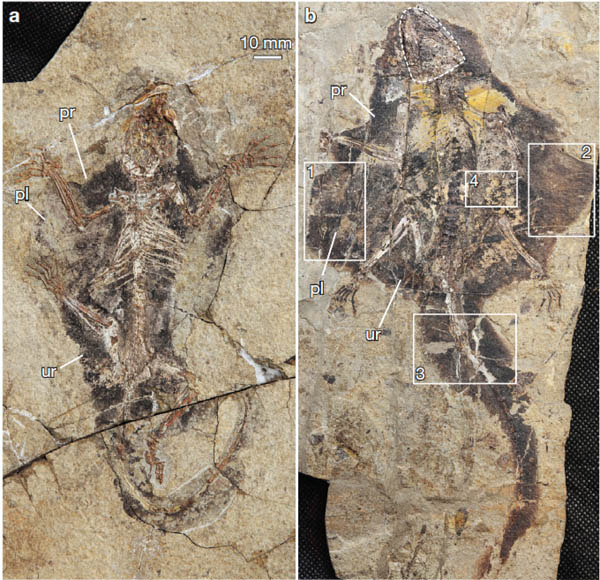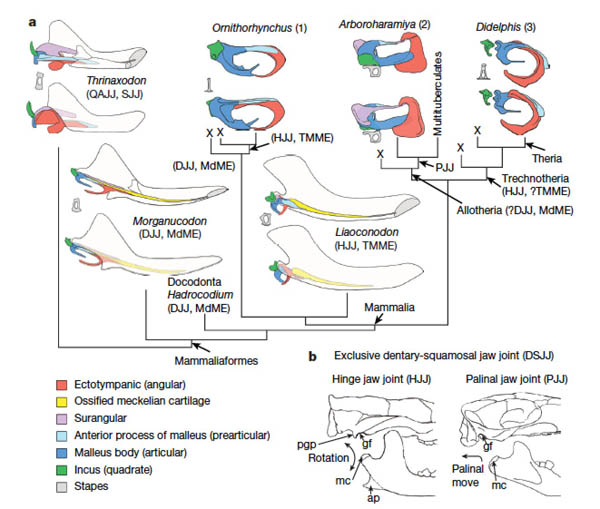Researchers from the Institute of Vertebrate Paleontology and Paleoanthropology, Chinese Academy of Sciences, and several research institutions in China and the United States jointly published a study on the biology of Yanliao in the early Late Jurassic in the British journal Nature on November 13. The research results of a new species of tree thieves - Aho's tree thieves. The new specimen was produced in the Tiaojishan Formation, Gangou Town, Qinglong County, Hebei Province. It dates from the early Late Jurassic (approximately 164-159 million years ago) and belongs to the Yanliao biota. The new material not only preserves the best details of gliding skin wings and hair imprints among thieves so far, but also preserves the earliest and most complete structure of the middle ear region among Mesozoic mammals, which is important for understanding the diversity and development of Mesozoic mammals. The evolution of the mammalian middle ear is of great significance.
The thieves are an extinct group of mammals that lived in the northern continent from the Late Triassic to the Late Jurassic. They are one of the earliest branches of mammals, and their taxonomic status has always been controversial. As early as 1847, fossil specimens of Thieves were discovered in Europe. Since then, although new material has been discovered, the vast majority of specimens consist of scattered teeth and only a few broken jaws. It was not until 2013 that a series of reports on Jin's tree thieves and subsequent mythical beasts, fairy beasts, celestial beasts, and ancestral beasts in Nature gradually revealed the origins of the extinct mammal group of thieves during the earth's history. Important morphological characteristics.
Aho's tree thieves have slender bones throughout the body, elongated bones of the front and rear limbs, main flanks between the front and rear limbs, front wings between the neck and forelimbs, and tail wings between the tail and hind limbs. There are regularly arranged hairs on the skin wings. The tail is long and can spread the hair. Their palms and soles have elongated finger (toe) bones, which reflect the skeletal characteristics of grasping and climbing abilities. These comprehensive characteristics are very similar to those of gliding species among living marsupials and rodents. So far, all the kleptozoan species in the Yanliao biota come from the period of about 164-159 million years ago. They all show the characteristics of adapting to arboreal habitats and having the ability to glide, representing a The arboreal taxa with high diversity in the Jurassic forest environment are second only to the earliest known Mesozoic gliding mammal published in 2006, which was produced in Daohugou, Ningcheng, Inner Mongolia and belongs to the Yanliao biota. Flying beast (about 168-164 million years ago).
In addition to the characteristics and fine structure adapted to gliding, Arhodon also preserved the most complete middle ear structure among early mammals. The evolution of the mammalian middle ear has always been a classic topic in the evolution of vertebrates. Since at least 1837, it has been recognized that the ossicles of the mammalian middle ear evolved from several bones associated with the jaw joints of reptiles. The middle ear of mammals is generally thought to consist of the stapes, incus, and malleus, in addition to the ectotympanum, which supports the eardrum. In contrast, the middle ear of reptiles has only one columella bone (=stapes). In the mandible of reptiles, in addition to the dentary bones to which the teeth are attached, there are several postdentary bones, namely: prearticular bone, articular bone, corner bone and superior corner bone. According to numerous studies in developmental biology and paleontology, it is basically accepted that the malleus of mammals is homologous to the prearticular bones and articular bones in the reptilian mandible, and the ectotympanic bone is homologous to the corner bone of the reptilian mandible. The incus is homologous to the square bone in the skull of reptiles. However, in the middle ear area of Aho's treethief, in addition to the above-mentioned bone fragments, it also retains the upper corner bone, which does not exist in the middle ears of any known mammals. These tiny bones are basically preserved in situ and completely detached from the mandible. They show the characteristics of typical mammalian middle ears. However, they are very different in shape from the corresponding bones of the mammalian middle ears known today. They represent A completely new type of mammalian middle ear. The emergence of this type may be related to the formation of the special mandibular joints of thieves and the chewing movement mode of the teeth.
In addition to providing extremely important morphological information, the discovery of the middle ear of T. ahoi also raised many challenging questions for the study of the evolution of the middle ear of existing mammals, which is of enlightening significance. To date, no studies have been able to answer the question of the fate of the superior corner bone in the postdentary bones of mammalian reptiles. The existence of the superior ossicle in the group of thieves indicates that during the evolution of the ear area of mammals, it entered the ear area like other ossicles and became part of the hearing organ. Therefore, in other early mammal groups, the supraclavicular bone may also be present in the middle ear, but may be fused with other bone fragments or lost during later evolution. This new discovery will prompt paleontologists to pay more attention to exploring the evolution of the mammalian middle ear, especially the fate of the superior bone. At the same time, it will also provide new reference clues to developmental biologists. In the study of the development of living mammals, pay attention to the possibility of the existence of the superior bone. Combined with new mammalian phylogeny research, the middle ear of Arhodon's tree thieves and the middle ears of extant mammals and monotremes should have evolved independently. This shows that the middle ear ossicles, a delicate and complex structure with important sensory capabilities, as well as the gliding movement method, have evolved independently many times in mammals.
This research was funded by the Basic Science Center Project of the National Natural Science Foundation of China "Cratonic Destruction and Terrestrial Biological Evolution", the National Natural Science Foundation of China, and the Strategic Priority Science and Technology Project of the Chinese Academy of Sciences (Category B). The three-dimensional scan of the fossil was completed at the High-Precision Computed Tomography (CT) Center of the Key Laboratory of Vertebrate Evolution and Human Origins, Chinese Academy of Sciences.
Original link: https://www.nature.com/articles/nature24483

Figure 1: Late Jurassic and early Arhodon treethief with wing membranes and hair impressions (Photo provided by Mao Fangyuan)

Figure 2: Parallel evolution of the middle ear in mammals (Photo provided by Mao Fangyuan)

Figure 3: Restoration diagram of Ahuo's tree thief (drawn by Shi Aijuan)
animal tags: evolution characteristics
We created this article in conjunction with AI technology, then made sure it was fact-checked and edited by a Animals Top editor.